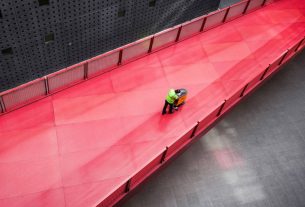Office buildings have many types of flooring and growing in popularity are stone floors. Stone floors give buildings a classic and upscale image. Popular choices in flooring these days are natural surfaces including marble, slate, granite, and terrazzo. As more and more buildings are installing stone floors there is a growing need for cleaning contractors who have the experience and knowledge to take care of these valued surfaces properly. Learning the tricks of stone floor care can lead to extra income and profit for your cleaning company.
Before expanding into the area of stone floor care make sure that you understand the differences in the types of flooring and how to design a maintenance program to keep stone floors looking their best. It helps to develop a relationship with a distributor that has quality products and can help you with technical support.
The first step in any floor maintenance program is finding out what type of stone you’re dealing with. Stone floors are broken down into one of two categories: stone that contains calcium and those that do not contain calcium. It is important to note that acids will attack and etch stone that contains calcium.
If the floor is not coated on the surface, a simple test can determine what type of stone you are dealing with. Place a drop of hydrochloric acid in an inconspicuous area and watch the reaction. If the acid fizzes the stone contains calcium. If there is no reaction, the stone is most likely granite, slate, sandstone or some type of ceramic that has been designed to look like natural stone.
Your second step is to decide what type of results you want with your floor program. Do you want a polished surface, a slip-resistant floor or a floor program that is easy to manage? Any stone floor program should also take into account the type of surface – polished, honed or textured. Also, remember that stone is a product of nature and should be admired for its inconsistencies. The imperfections of stone create random patterns, which is what makes a natural stone so desirable.
When looking at how you should maintain stone floors, both calcium-containing and non-calcium containing stone floors should be maintained in identical ways except when it comes to re-polishing. A marble floor develops wear patterns faster as marble is a softer stone. You can polish marble, limestone, and terrazzo effectively with superfine abrasives you mix with potassium oxalate or oxalic acid. These are typical compounds available in various ready to use formulas.
Granite floors, on the other hand, are acid-resistant requiring granite to be polished mechanically using superfine abrasives. The re-polishing of granite is a slow process as compared to re-polishing a marble floor.
At times the floor will have been so neglected it may need restoration. A properly restored stone floor will have no lippage (where one edge of a stone is higher than adjacent edges, giving the stone a ragged appearance), will look better and be easier to clean. The restoration process is best handled by professionals. Improved technology has made the restoration process faster and with restored floor maintenance costs will go down while the overall appearance of the floor will go up.
The stone itself has a porosity factor (materials can pass through it) and some stones absorb stains faster than other types of stone. A high-quality impregnator can help prevent stains from passing through and being absorbed into the stone. Impregnators can be water-resistant, or water, grease and oil resistant. The specific impregnator to use will depend on your specific situation.
The most important part of your stone floor care program will be the use of a quality stone soap. A high-quality soap will clean and enrich the stone, which will make it more soil and stain-resistant. This is not an area to be cutting costs!
Quarterly cleaning is recommended for commercial stone floors. This will not only remove any built-in soil but will also remove stone soap build-up. This is an important step as most stone soaps are non-rinse. Because of this dirt can build up in the grout lines, even when you are following a floor maintenance program. An intensive cleaning should also be used if you have an extremely dirty floor.
Other stone surfaces that may need extra care are countertops, vanities and vertical surfaces, such as pillars. A good relationship with a distributor of quality products will help you in deciding which chemicals you’ll need to use to clean these surfaces.
If you have buildings with stone floors, your first step is to develop a quality stone floor care program. Spending a little time and effort before beginning your stone floor program will save you headaches and keep the floor looking its best. Your customer will be happy and your bank account will grow!





